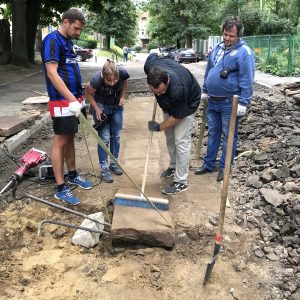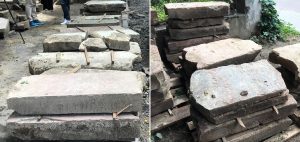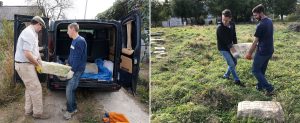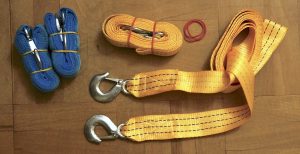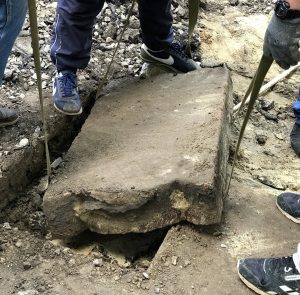![]() Ця сторінка також доступна українською.
Ця сторінка також доступна українською.
Mankind has adapted stone as a building material for thousands of years. Because stone is dense, even small blocks can be quite heavy to lift and move without machinery. Typical prewar Jewish headstones in western Ukraine weigh hundreds of kilograms regardless of the type of stone from which they were carved. Wartime and postwar conditions in the region resulted in severe devastation to Jewish cemeteries; many sites now have only toppled headstones, or no headstones at all – the materials having been harvested for building and road construction projects during the German occupation and/or the subsequent Soviet era. This means that recovery of displaced Jewish headstones and their return to their cemeteries of origin or memorial sites is a common need throughout western Ukraine.
Fortunately the types of tools which aid the extraction and movement of headstones and fragments are commonly available in the region, and many people in the area know how to use them from experience in the building trades. Most of the tools and methods described here are suitable for manual movement of stones by one person, or more typically, by several people working together to distribute the weight of larger stones. Vehicles are often used to move stones over distances greater than a few tens of meters, and for large batches of stones or especially large individual stones, the use of lifting machinery may be appropriate.
Tools for stone conservation, including specialized tools for uprighting and resetting headstones at precise grave locations in a cemetery, are described separately in the stone conservation section of this website. Information about the density of common historical headstone materials, and other stone properties, is provided in the data section of this website.
Stone Extraction and Preparation for Recovery: Shovels and Pry Bars
Before a headstone can be recovered and transported to its destination cemetery or memorial site, often the stone must first be extracted from soil or from the construction in which it was found, perhaps a walkway or a road or the foundation of a building. In some cases extracting the headstone and preparing it for transport may require specialized building tools (e.g. a mallet and chisel, hammer drill, rotary hammer, or jackhammer) to break up hard materials covering or retaining the stone, but often the only tools needed are simple gardening or demolition tools, for example shovels and pry bars.
Shovels can be used whenever the stone is embedded in soil, clay, sand, or other grainy material. Removing the soil or other material from around the stone makes it possible to insert lifting tools underneath the stone, to begin the moving process. The type of material surrounding the stone determines the optimum shovel type for removing it, e.g. either a square shovel for loose materials, a pointed shovel for compacted soil or clay, or a rigid spade to break up harder or very compacted soil. In western Ukraine, shovels suitable for headstone recovery and other cemetery preservation projects are available from almost any building materials shop and through internet warehouses in prices ranging from US$10 to US$40 and more depending on tool materials, fabrication quality, and features; many good-quality shovels are available for around $25. Although this is rarely needed, shovel edges which become dull or nicked through heavy use can be sharpened with a common flat file.
Pry bars (also called crowbars, wrecking bars, or more generally, utility bars) are used to separate adjacent stones, to raise the ends or sides of stones to give access underneath to insert lifting tools, and generally to maneuver the stones over short distances to prepare them for recovery. Care must be exercised when bearing on the edges or decorative faces of headstones with metal pry bars, as the stone surface can be damaged; sometimes pieces of wood can be used between the stone and the tool to spread the contact stress during movement. For extracting large headstones, the preferred pry bar is long (around 1.5m), with a straight point or blunt chisel edge at one end, and a hook or L-bend at the other end which makes a fulcrum for creating mechanical advantage, to multiply human force in the form of a lever. For smaller stones, and occasionally for gaining initial access under the edges of larger stones, a smaller crowbar (up to 1.0m) may be best. If the pry bar does not have a suitable bend at one end, a fulcrum for lever action can be created out of any waste stone at the site, by a large piece of scrap wood, or another hard object with sufficient size and strength. Sometimes the pointed end of a pry bar can also be used to break up compacted soil around a stone, or scrape out loose material from between several adjacent stones to provide access for prying. Small pry bars are available in western Ukraine at ordinary building materials shops and online for US$10 to US$40; larger heavy-duty pry bars are available from commercial building supply and tool shops for US$25 and up.
If more than one headstone or fragment needs to be moved, sometimes the stones are best stacked to keep them together. To reduce damage to the headstone surfaces and edges, it is beneficial to place some softer material between the stones, and between stones and other hard surfaces, so that contact stress does not chip or crumble the stone. If the headstones or fragments are small enough to be moved without tools, cloth or shipping foam sheets may be adequate padding. If tools will be needed for subsequent movement of the stones, then wooden sticks or rods are suitable; the wood is soft enough to be crushed instead of the stone at points of high contact stress, and the sticks will create a gap between headstones so that pry bars or straps can be inserted when the stone is ready to be moved again.
Small/Simple Stone Moving: Hands
Smaller intact headstones and fragments of broken headstones may be most easily moved by hand by one or more people, if the shape of the stone is not too awkward to carry. Typically, cubic fragments up to 25kg or more may be carried safely by one strong person; larger flat slabs may be carried by two or four people if the stone is thin enough so that its weight is not excessive. Carrying a stone by hand gives the best grip on the stone of all of the methods described here, but with two or more people the coordination required makes this method less safe, even if quick. Normal precautions to avoid strain and injury from heavy lifting should be observed, and heavy shoes and well-fitted gloves are advised. The biggest risk to safety is that, to carry the stone by hand and not strain their backs, volunteers typically raise the stone to near waist height and hold the stone close to their bodies; if the volunteers lose their grip on the stone, it will fall from sufficient height to risk very serious injury to their legs and feet.

Headstones and fragments being moved by hand by volunteers with the LVC at the new Jewish cemetery in Lviv. Photos © Sashko Balabai and RJH.
Despite the safety risks, many smaller headstone recovery efforts in western Ukraine are performed partly or entirely by hand. For larger efforts, simple tools as described below are helpful.
Large Stone Moving: Lifting Straps
One simple and inexpensive tool to aid moving headstones over short walking distances is the flexible lifting strap, commonly used in sets of two or more depending on how large and heavy a headstone is. The typical strap suitable for this purpose has a thin and flat cross-section, 6 to 10cm wide, and at least 2.5m long (but longer lengths are better). The strap material should be very strong and should resist wear from abrasion. In western Ukraine, the common material adapted for lifting headstones is automobile towing straps, which are typically made of nylon webbing and are remarkably strong and durable despite their light weight. Automobile towing straps are sold in pairs, in lengths of 3 to 6m, with either a sewn loop or a latching metal hook at each end; in western Ukraine, pairs of straps are available in auto parts stores and warehouse stores, plus online, for US$10 to US$40. For lifting headstones with straps without machinery, the version with sewn loops is best, because it can fit most easily in narrow gaps between stones; for lifting stones with machinery, the version with latching metal hooks is quicker because the strap can be looped around the machine and hooked safely to itself (although the sewn loops would also work for this, using separate hooks to connect the loops).
To use the straps, first hands, pry bars, or other tools are used to lift the headstone a small height off of the ground, usually one end at a time, and a strap is laid flat beneath the stone near the raised end; the procedure is repeated at the other end of the headstone. Then four people each grab one strap end, pull the strap taut with their partner at the other end of the strap, and together all workers lift the headstone a short height off of the ground so that it is free to move. For the safety of the workers and the stone, during transit the stone should just barely clear the ground, and the strap length at the hand grip should be set so that the workers are mostly upright, lifting with their legs and with their arms mostly straight down. Coordinating their movements, the workers then slowly carry the stone by the straps to the desired location for storage or further transport. Releasing the straps again requires lifting one end of the stone with hands or a tool and pulling each strap free, one or two at a time. Like all stone movement methods, this one is risky for workers and everyone must be attentive so that their feet do not move under the stone.
Larger and heavier stones can be carried using three straps and six workers, with the center strap placed at the same time as one of the end straps. Coordinating walking by six workers close together with the heavy load of a large headstone can be difficult, so communicating before and during the movement is critical. Often, moving a large stone is best done in several short transits, carefully setting the stone down on the ground at each stopping point to allow the workers to rest and consider strategy for the next step.

Moving a variety of recovered Jewish headstones in Lviv with lifting straps in 2018 and 2019. Photos © RJH.
Large Stone Moving: Lifting Hooks
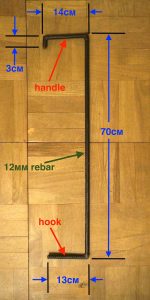
Dimensions of a typical steel lifting hook; click on the image to download a larger version. Image © RJH.
An alternative to lifting straps for moving large headstones with groups of workers is metal lifting hooks. There is no off-the-shelf version of this tool available in shops, but the materials from which they are made are inexpensive and readily available, and the fabrication is simple for people with basic metalworking equipment and skills. Advantages of lifting hooks over lifting straps for headstone recovery and movement are that the hooks can often be inserted beneath the edge of a stone with little or no lifting of the stone, the handles on the lifting hooks can make them easier to grip than straps, and the hooks do not need to be used in pairs: any number of workers (3 or more) can group themselves around the stone to lift and carry it. Disadvantages of lifting hooks are that the metal hook end can scrape or chip the headstone surfaces and edges, if not used carefully, and if the stone is tilted significantly during movement or if the hook is not inserted fully under the stone, the hook may lose its grip on the stone and the stone can fall at the supported corner.
Typically, lifting hooks are fabricated from steel reinforcing bar (rebar) such as is used to strengthen poured concrete. A one-meter length of rebar is a good part to work from, as it results in a reasonable finished hook length for average-height and tall workers to use; see the drawing at right for typical dimensions of fabricated hooks used in western Ukraine. Experience suggests that the optimum diameter of rebar stock from which to make the hooks is 12mm; this is thick enough that the hooks will not bend when carrying heavy stones, but it also means that the rebar must be cut and welded at the corners to make the lifting hook. Smaller rebar diameters (e.g. 10mm) can be bent into shape instead of cut and welded, but when carrying heavy stones the lower hook end of the lifter can yield and lose its shape, rendering it unusable. A set of 8 lifting hooks made from 12mm diameter rebar stock, including the raw material, cutting, and welding can be fabricated for less than US$50 in western Ukraine.
Using a set of lifting hooks is simple, though of course careful movement and coordination between workers is essential to reduce the risk of injury to workers and damage to the stones. As for any headstone recovery process, access to the lower edges of the stone must first be provided by shovels or other tools, but only enough to insert the lower hook end of the lifter beneath the stone. Workers can arrange themselves around the stone at convenient places where the stone has adequately square edges, and to allow them to carry the stone without stepping on each others’ feet. An important caution is that the stone should remain level during lifting and movement so that the hooks remain engaged under the stone, and the stone does not fall.

Moving headstones in Lviv and Rohatyn with 3, 4, and 6 lifting hooks. Photos © Sashko Balabai and RJH.
Large Stone Moving and Transport: Machinery
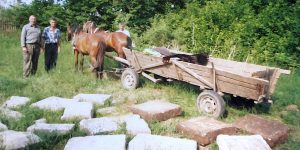
Recovering Jewish headstones in Rohatyn with hand labor and traditional equipment. Photo © Mykhailo Vorobets.
Some individual headstones are too large and heavy to be moved by hand, even with simple hand tools and several strong workers. In other situations, the number of headstones to be recovered is too large to be practically managed by hand in a reasonable period of time. For recovered stones which must travel a distance to return to their cemetery of origin or another memorial site, transport by hand is not feasible. In all of these cases, some type of machinery, powered by human/animal strength or by motor, is appropriate.
Mechanical advantage in machines can multiply human power to lift very heavy stones. For example, an ancient device called the winch is a compact machine which commonly uses gears to create the force-multiplying effect. Attached to a tripod or other stable structure, winches can be used to lift stones suspended on lifting straps (as described above) over short distances vertically; attached to a gantry, a winch becomes a crane which can raise a heavy stone and move it horizontally. Related simple machines for amplifying lifting force include the differential windlass and the block and tackle, both of which have been in use for millennia. All of these devices are available for purchase in western Ukraine in a variety of modern forms, typically intended for packing, shipping, and light industrial use.

A mobile hydraulic crane in use in Lviv to lift and transport large number of recovered headstones. Photos © RJH.
Adding one or more motors makes some devices even more powerful, particularly when coupled to hydraulic pumps and actuators to make a range of hydraulic machinery suitable for lifting and moving heavy stones. Examples include general-purpose loaders, backhoes, tractors with power take-off systems or external hydraulics connected to actuated arms and hooks, construction forklifts, and truck-mounted hydraulic arms (light-duty mobile loader cranes). These machines and their operators are available for rent in western Ukraine; costs are based on usage time (typically around US$25/hour for a tractor or mobile loader) and the distance traveled to and from the work site, usually with a minimum charge.

A construction truck transporting recovered headstones to the old Jewish cemetery in Rohatyn. Photos © RJH.
Transport of displaced headstones from the point of recovery to their cemetery of origin or to another memorial site is typically achieved by cart, trailer, or truck; smaller sizes and quantities can be transported in ordinary passenger cars and vans, if care is taken so that the stones do not damage the vehicle or other stones. Smaller vehicles with drivers can be rented in western Ukraine for US$0.30 to US$0.50 per kilometer with a minimum charge; larger trucks of course cost more, and the fee for use of horse-drawn carts and other equipment is usually negotiated on the spot.

